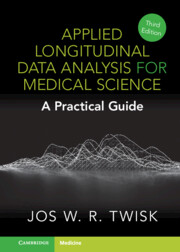Book contents
- Applied Longitudinal Data Analysis for Medical Science
- Applied Longitudinal Data Analysis for Medical Science
- Copyright page
- Dedication
- Content
- Preface
- Acknowledgements
- Chapter 1 Introduction
- Chapter 2 Continuous Outcome Variables
- Chapter 3 Continuous Outcome Variables: Regression-based Methods
- Chapter 4 The Modelling of Time
- Chapter 5 Models to Disentangle the Between- and Within-subjects Relationship
- Chapter 6 Causality in Observational Longitudinal Studies
- Chapter 7 Dichotomous Outcome Variables
- Chapter 8 Categorical and Count Outcome Variables
- Chapter 9 Outcome Variables with Floor or Ceiling Effects
- Chapter 10 Analysis of Longitudinal Intervention Studies
- Chapter 11 Missing Data in Longitudinal Studies
- Chapter 12 Sample Size Calculations
- Chapter 13 Software for Longitudinal Data Analysis
- References
- Index
Chapter 1 - Introduction
Published online by Cambridge University Press: 20 April 2023
- Applied Longitudinal Data Analysis for Medical Science
- Applied Longitudinal Data Analysis for Medical Science
- Copyright page
- Dedication
- Content
- Preface
- Acknowledgements
- Chapter 1 Introduction
- Chapter 2 Continuous Outcome Variables
- Chapter 3 Continuous Outcome Variables: Regression-based Methods
- Chapter 4 The Modelling of Time
- Chapter 5 Models to Disentangle the Between- and Within-subjects Relationship
- Chapter 6 Causality in Observational Longitudinal Studies
- Chapter 7 Dichotomous Outcome Variables
- Chapter 8 Categorical and Count Outcome Variables
- Chapter 9 Outcome Variables with Floor or Ceiling Effects
- Chapter 10 Analysis of Longitudinal Intervention Studies
- Chapter 11 Missing Data in Longitudinal Studies
- Chapter 12 Sample Size Calculations
- Chapter 13 Software for Longitudinal Data Analysis
- References
- Index
Summary
In Chapter 1 the different medical study designs are discussed and the difference between age, period and cohort effects is explained. Furthermore, some general information (e.g. prior knowledge, software used for the examples) needed to work through the book is provided. Finally, there is a short section in which the differences between the second and third edition are outlined.
Keywords
- Type
- Chapter
- Information
- Applied Longitudinal Data Analysis for Medical ScienceA Practical Guide, pp. 1 - 6Publisher: Cambridge University PressPrint publication year: 2023

